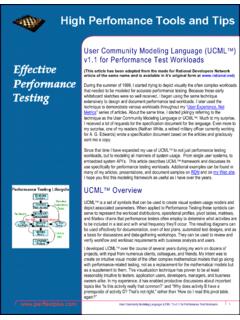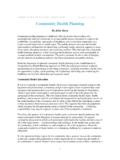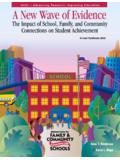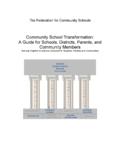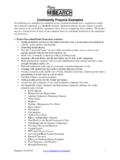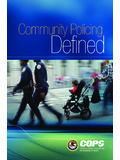Transcription of Community Key Performance Indicators …
1 Community Key Performance Indicators ( Community kpis ) for the IoT and Smart Cities A Collaborative Framework for Project Assessment Drew Hemment, Mel Woods, Vimla Appadoo, Lily Bui Community Key Performance Indicators ( Community kpis ) for the IoT and Smart Cities A Collaborative Framework for Project Assessment Authors Drew Hemment Mel Woods University of Dundee & FutureEverything University of Dundee Vimla Appadoo Lily Bui FutureEverything MIT. FutureEverything Report August 2016. 1. Contents 1. Introduction 4. About CityVerve 4. Introducing a People-Centred Approach to IoT and Smart City Development 6. A Need for Community Key Performance Indicators ( Community kpis ) 8. Scope 9. 2. Community Key Performance Indicators 10. What are Community kpis ? 10. Foundations of Community kpis 10.
2 Example of a Community KPI 11. Why Evaluate IoT & Smart Cities Projects? 12. When to Evaluate 13. Before: Establishing a baseline and goals 13. During: Tracking progress 13. After: Measuring changes and outcomes 13. Who is Involved 14. Who is the Community , and How Representative is the Sample 15. More on Community Champions 16. What Should be Evaluated 17. Limitations 17. Replicability 18. 3. Toolkit: Creating and Evaluating Community kpis 19. A Collaborative Framework for Assessment 19. Workshop: Envisage 21. Mini-Workshop: Iterate 25. Mini-Workshop: Assess 27. Workshop: Reflect 30. 4. Reporting tools 33. Reporting Template for Goals, Indicators , and Outcomes 33. Digital Tools for Sustained Community Engagement 35. 5. References 36. List of Figures Fig. 1. Process for collaborative development of Community kpis 7.
3 Fig. 2. Constellation of Community stakeholders 14. Fig. 3. Framework for Development of Community kpis in IoT & Smart City projects 20. Fig. 4. Creating observational systems for assessing Community kpis 28. 2. About FutureEverything Publications and Reports Each year FutureEverything proposes, develops and responds to particular themes. These themes are provocations, designed to open up a space for debate and practice, made tangible through art and design projects. FutureEverything Publications seek to contribute to an international dialogue around these themes. FutureEverything Reports seek to contribute to best practice by disseminating frameworks, methods, results and findings. Dr. Drew Hemment Founder & Creative Director, FutureEverything 3. 1. Introduction Community kpis are proposed and introduced in CityVerve as one way to build meaningful participation by local residents and communities in the governance and design of a major IoT and Smart Cities project.
4 The proliferation of sensor and data analysis technologies offers new ways to configure cities we have seen this applied in streetlamps, vehicles, heating equipment, bus stops, air quality monitoring, and so on. These emerging technologies have given rise to the Internet of Things' (IoT), networks of devices and sensors that can communicate with each other (Anderson, 2014). By extension, the IoT. provides enabling technology for Smart Cities'; cities in which ubiquitous sensors and devices allow for more efficient processes of city management, smoother flow of systems, and optimized use of infrastructure (Hollands, 2008; Komninos, 2009). However, a city is never merely its buildings, open spaces, streets, or vehicles. Nor is technology there solely for engineers to optimise processes.
5 IoT and Smart City development can make lasting changes to the places in which people live, work and play. It can shape neighbourhoods and the lives of residents, in the same way as the development of urban road systems did in the 20th Century. Therefore residents and communities have a stake, and need a voice, in deciding which technologies are most relevant to them, as well as defining the processes that measure the success of these technologies. About CityVerve CityVerve is the UK's Internet of Things Smart City Demonstrator, a large scale project funded by InnovateUK ( 10M) that aims to make Manchester a world leader in Smart City' and Internet of Things' technology. It is led by the City of Manchester and is made of up 18 partners, including FutureEverything, the project lead for Culture and Public Realm, with specific deliverables in Human Centred and Participatory Design, Citizen Engagement, and Art Commissions.
6 Starting with Manchester, CityVerve hopes to create projects, tools, and a way of doing things with Internet of Things Smart City technologies that can be replicated in cities around the world. In CityVerve, there are a number of individual projects (or use cases') that implement and demonstrate IoT technologies and design solutions for Manchester, within four themes: Transport, Culture, Health, Energy. The project ideas, developed during the process of writing the bid, include: 4. 4 ALKATIVE BUS STOPS - CityVerve will convert flag and pole' bus stops into safe places with location-based services, sensors/beacons, mobile apps and intelligent digital signage. People will check-into their bus stop and let bus operators know they are waiting for their service. Management of chronic respiratory conditions - CityVerve will set up a biometric sensor network' which will help improve responses to patients' conditions and improve how local healthcare services work.
7 Community wellness - a network of sensors positioned in parks, along commuter and school routes will track the progress of individuals and teams competing against each other for physical activity and fun. Examples include the Great Space Race Challenge for Manchester residents to walk the distance to the moon. 3 MART LIGHTING - Manchester, like many cities, is seeing a growth of traffic and congestion. To reduce car use, alternative forms of transport need to be attractive and safe. Smart lighting, in addition to connected street lighting, will help address this. Bike sharing - The Manchester Corridor through-route will soon become bus and bike only. Bike sharing schemes can be expensive to install and maintain, and so an alternative is to use Internet of Things enabled bikes in a crowd-sourced and maintained, secure bike sharing service.
8 It will also include e-cargo' bikes to make last-mile' deliveries on the Corridor. 3 MART AIR QUALITY MONITORING - Street furniture and connectivity infrastructure such as lamp posts and street cabinets on the Manchester Corridor will be used to monitor air quality at different heights and locations. Information will be passed to those with health conditions and made generally available to support walking options and routes. 3 OCIAL PLATFORM - An online social network access through local wi-fi hotspots, giving access to cultural events as well as Community and commercial services. Community kpis , and a wider human centred and participatory design approach, are proposed and piloted in CityVerve. (1) The aim is to involve communities and residents in the design process, and to engage them as stakeholders and contributors to define and measure success criteria for the project.
9 In an ideal scenario, citizen input would be incorporated at the outset of a project during design and ideation phases so that communities can have a say in the conceptualisation of the technological solutions themselves. The methods and principles described in this report are designed to support this approach. In CityVerve, citizens were not involved in early phases of design and ideation of project ideas due to the nature of the project structure and timeline. Presented in this report, therefore, is not a full human centred design journey but rather the incorporation of human centred design and citizen engagement principles and methods into project ideas that have already been proposed. Nevertheless, citizens can still play a significant role in project design and assessment using the methods described below.
10 These constraints are discussed further in Section ( Limitations'). (1) The framework proposed in this report is built on prior work in a citizen sensing project, Making Sense (http://making-sense. eu) where Community Level Indicators are co-created by citizens not only to define, track and measure progress towards their objectives and outcomes, but additionally, to annotate sensor data for extended analysis. Community Level Indicators were conceived and applied in the context of IoT and citizen sensing for environmental monitoring (Woods, Hemment, Bui, 2016). 5. )NTRODUCING A PEOPLE CENTRED APPROACH TO )O4 AND . 3 MART #ITY DEVELOPMENT. In the past, IoT and Smart City projects have tended to privilege a top-down approach, over human-centred design, and with little or no engagement of citizens in design or assessment.

